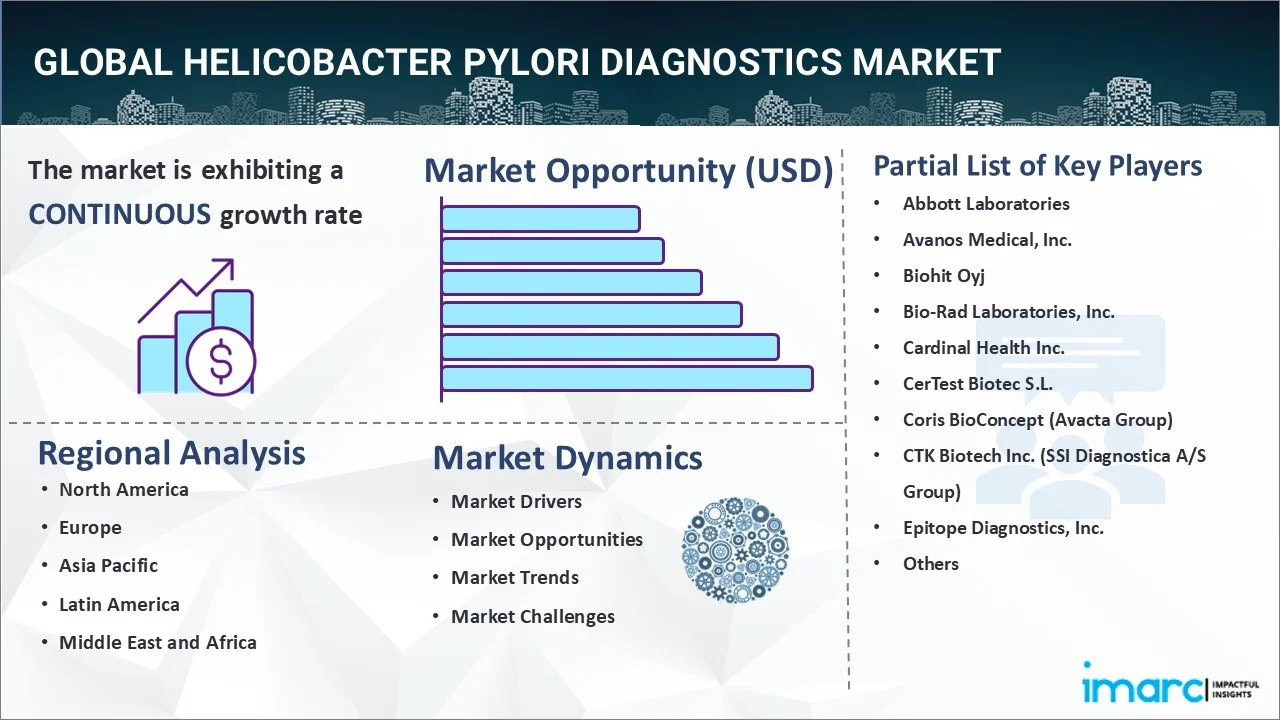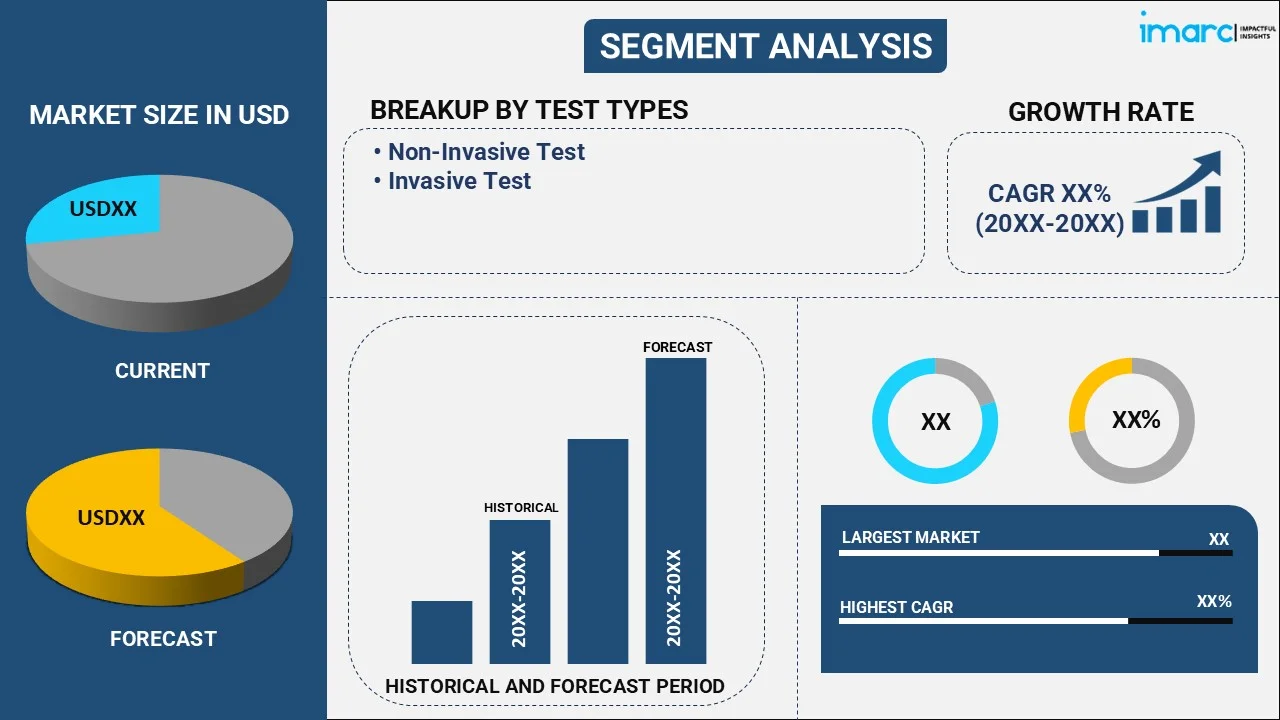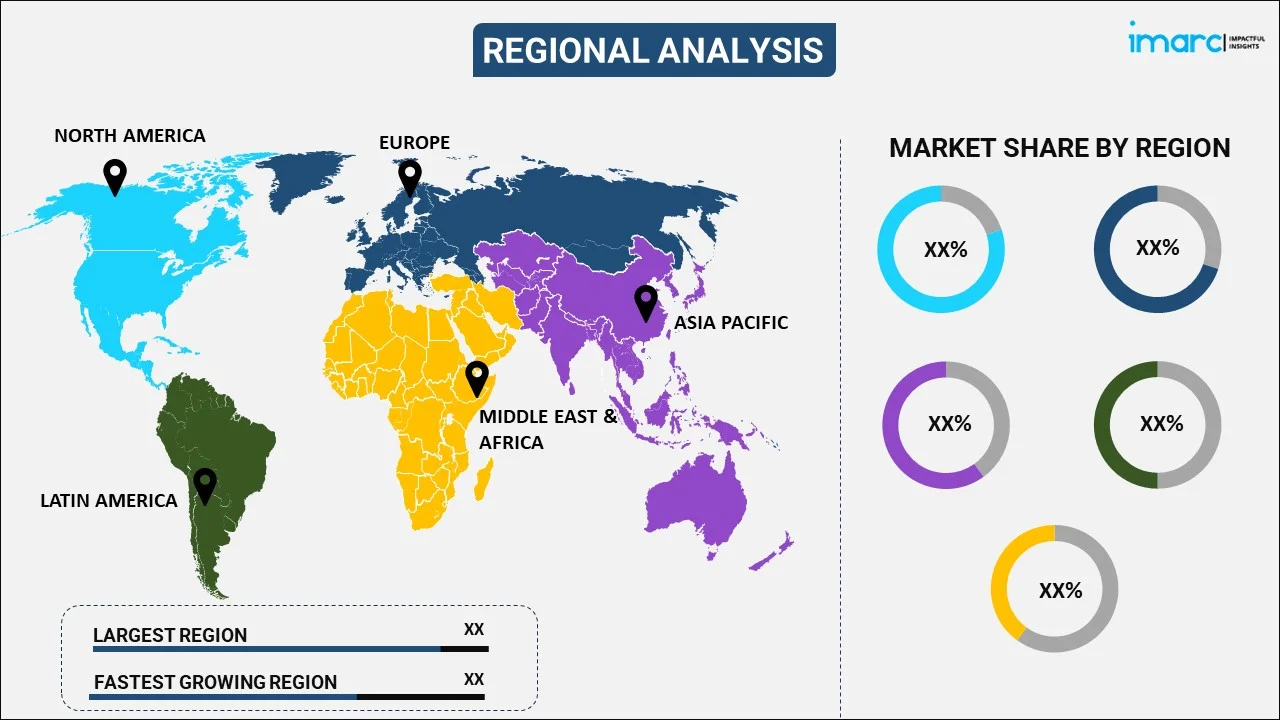
Helicobacter Pylori Diagnostics Market Report by Test Type (Non-Invasive Test, Invasive Test), Method (Laboratory Based Test, Point of Care Test), End User (Diagnostics Laboratories, Hospitals, and Others), and Region 2025-2033
Market Overview:
The global helicobacter pylori diagnostics market size reached USD 585.7 Million in 2024. Looking forward, IMARC Group expects the market to reach USD 918.8 Million by 2033, exhibiting a growth rate (CAGR) of 4.72% during 2025-2033. The growing prevalence of helicobacter pylori infections among individuals, rising adoption of various screening tests and programs among the masses, and innovative advancements in diagnostic technologies are some of the major factors propelling the market.
|
Report Attribute
|
Key Statistics
|
|---|---|
|
Base Year
|
2024 |
|
Forecast Years
|
2025-2033
|
|
Historical Years
|
2019-2024
|
| Market Size in 2024 | USD 585.7 Million |
| Market Forecast in 2033 | USD 918.8 Million |
| Market Growth Rate (2025-2033) | 4.72% |
Helicobacter pylori diagnostics comprise various methods and tests to identify the presence of the bacterium helicobacter pylori in the gastrointestinal tract of individuals. The diagnostic methods for helicobacter pylori include non-invasive and invasive methods, such as serological tests and endoscopy with biopsy. It assists in providing accurate and timely detection of the bacterium and allows healthcare professionals to initiate appropriate treatment and management strategies for affected individuals. As it aids in reducing the risk of complications and promoting better gastrointestinal health, the demand for helicobacter pylori diagnostics is increasing across the globe.

At present, rising incidences of gastric cancer among individuals are contributing to the growth of the market. In line with this, the increasing adoption of helicobacter pylori diagnostics among the geriatric population, as they are more prone to helicobacter pylori infections and related gastrointestinal conditions, is strengthening the growth of the market. Apart from this, the growing demand for helicobacter pylori diagnostics on account of the improving healthcare infrastructure facilities around the world is positively influencing the market. In addition, the increasing focus on preventive healthcare practices and early disease detection among the masses across the globe is bolstering the growth of the market. Furthermore, governing agencies of various countries are encouraging the adoption of diagnostic tests by offering various reimbursement schemes to patients, which is supporting the growth of the market.
Helicobacter Pylori Diagnostics Market Trends/Drivers:
Rising prevalence of helicobacter pylori infections among individuals
There is a rise in the adoption of helicobacter pylori diagnostics due to the increasing prevalence of helicobacter pylori infections among the masses across the globe. In line with this, helicobacter pylori is one of the most common bacterial infections that is affecting a large portion of the population around the world. The bacterium is known to colonize the stomach lining and can lead to chronic gastritis, peptic ulcers, and even gastric cancer among individuals. In addition, the rising demand for helicobacter pylori diagnostic on account of the increasing awareness about the link between helicobacter pylori and gastrointestinal disorders is contributing to the growth of the market. Furthermore, healthcare providers and individuals are focusing on early detection and treatment.
Innovative advancements in diagnostic technologies
Various manufacturers are increasingly focusing on advancing diagnostics tests related to helicobacter pylori that aid in improving the accuracy and efficiency of diagnostics. In addition, non-invasive tests, such as serological tests that detect specific antibodies in the blood, and breath tests that measure exhaled urea, are rapidly gaining popularity due to their convenience and patient-friendly nature. Moreover, advanced endoscopic techniques, such as magnifying endoscopy with narrow-band imaging (NBI), that allow more precise visualization, are offering a positive market outlook. Apart from this, healthcare providers are rapidly adopting advanced technologies in helicobacter pylori diagnostics, as they assist in improving diagnostic accuracy in real time.
Growing adoption of various screening programs
There is a rise in the adoption of screening tests due to the increasing prevalence of helicobacter pylori among the masses around the world. In addition, the growing preference for screening and diagnostic tests on account of the increasing awareness about the health risks associated with helicobacter pylori infections is offering a positive market outlook. Apart from this, governing agencies and healthcare organizations of various countries are taking several initiatives to implement helicobacter pylori screening programs, especially in regions with a high prevalence of gastric diseases, which is bolstering the growth of the market. These screening programs aim to identify and treat helicobacter pylori infections at an early stage, reduce the risk of complications, and improve patient outcomes.
Helicobacter Pylori Diagnostics Industry Segmentation:
IMARC Group provides an analysis of the key trends in each segment of the global helicobacter pylori diagnostics market report, along with forecasts at the global, regional and country levels from 2025-2033. Our report has categorized the market based on test type, method, and end user.
Breakup by Test Type:

- Non-Invasive Test
- Invasive Test
Non-invasive test represents the largest market segment
The report has provided a detailed breakup and analysis of the market based on the test type. This includes non-invasive test and invasive test. According to the report, non-invasive test represented the largest segment.
Non-invasive tests for helicobacter pylori are those tests that do not require direct access to the gastrointestinal tract. These tests are usually preferred due to their convenience and patient-friendly nature. The main types of non-invasive tests for helicobacter pylori are serological tests and breath tests. Serological tests assist in detecting specific antibodies against helicobacter pylori in the blood. They are easy to perform and suitable for initial screening and population-based studies. On the other hand, breath tests involve the measurement of exhaled gases, such as carbon dioxide or ammonia, after the ingestion of a specific substance, such as urea.
Invasive tests for helicobacter pylori involve accessing the gastrointestinal tract to directly observe the stomach lining and collect tissue samples for laboratory analysis. The main invasive tests for helicobacter pylori are endoscopy with biopsy. This procedure involves the use of a flexible and lighted tube that is inserted through the mouth or nose into the stomach.
Breakup by Method:
- Laboratory Based Test
- Point of Care Test
Laboratory based test accounts for the majority of the market share
The report has provided a detailed breakup and analysis of the market based on the method. This includes laboratory based test and point of care test. According to the report, laboratory based test represented the largest segment.
Laboratory-based tests for helicobacter pylori are conducted in specialized medical laboratories. These tests involve the collection of patient samples, which are then sent to the laboratory for analysis. The main types of laboratory-based tests for helicobacter pylori are serological tests and molecular tests. The serological tests are processed in clinical laboratories and are generally available within a few days. Besides this, molecular tests require specialized equipment and expertise and are commonly found in clinical or research laboratories.
Point-of-care tests for helicobacter pylori are designed to be performed near the patient that provides rapid results and can be obtained during a single clinical visit. These tests are valuable in settings with limited access to laboratory facilities. The main types of point-of-care tests for helicobacter pylori include rapid antigen tests and urea breath tests.
Breakup by End User:
- Diagnostics Laboratories
- Hospitals
- Others
Diagnostics laboratories hold the biggest market share
The report has provided a detailed breakup and analysis of the market based on the end user. This includes diagnostics laboratories, hospitals, and others. According to the report, diagnostics laboratories represented the largest segment.
Diagnostics laboratories are specialized in conducting various diagnostic tests, such as serological tests and molecular tests, to detect the presence of helicobacter pylori in patient samples. Additionally, diagnostics laboratories usually handle a large volume of tests and play a crucial role in providing accurate and timely results to healthcare providers.
Many hospitals have their own in-house laboratories equipped to perform various diagnostic tests. In larger healthcare facilities, such as tertiary care hospitals, the volume of helicobacter pylori tests can be substantial due to the high number of patients seeking diagnosis and treatment for gastrointestinal issues.
Other categories include various healthcare settings, such as primary care clinics, gastroenterology clinics, academic research institutions, and public health organizations. These settings may perform helicobacter pylori diagnostics to screen individuals at risk or conduct research studies.
Breakup by Region:

- North America
- United States
- Canada
- Europe
- Germany
- France
- United Kingdom
- Italy
- Spain
- Others
- Asia Pacific
- China
- Japan
- India
- South Korea
- Australia
- Indonesia
- Others
- Latin America
- Brazil
- Mexico
- Others
- Middle East and Africa
North America exhibits a clear dominance, accounting for the largest helicobacter pylori diagnostics market share
The report has also provided a comprehensive analysis of all the major regional markets, which include North America (the United States and Canada); Europe (Germany, France, the United Kingdom, Italy, Spain, and others); Asia Pacific (China, Japan, India, South Korea, Australia, Indonesia, and others); Latin America (Brazil, Mexico, and others); and the Middle East and Africa. According to the report, North America represented the largest market.
North America held the biggest market share due to the increasing prevalence of gastrointestinal diseases among individuals. In line with this, the rising consumer awareness about the association between helicobacter pylori and gastric diseases is propelling the growth of the market in the region. Apart from this, the increasing employment of helicobacter pylori diagnostics due to improving healthcare facilities is contributing to the growth of the market. In addition, the rising adoption of helicobacter pylori diagnostics due to favorable government initiatives is supporting the growth of the market.
Competitive Landscape:
Key players are investing in research and development (R&D) activities to innovate and improve their helicobacter pylori diagnostic tests. In addition, they are launching new diagnostic products catering to different end-users and market segments. These product launches include both laboratory-based tests and point-of-care tests, that aid in addressing the diverse needs of healthcare providers and patients. Apart from this, many companies are focusing on developing and commercializing point-of-care helicobacter pylori tests to meet the demand for on-site and near-patient testing. In line with this, major manufacturers are obtaining regulatory approvals and certifications for their diagnostic products, as compliance with international quality standards and local regulations is crucial to gain trust and acceptance.
The report has provided a comprehensive analysis of the competitive landscape in the market. Detailed profiles of all major companies have also been provided. Some of the key players in the market include:
- Abbott Laboratories
- Avanos Medical, Inc.
- Biohit Oyj
- Bio-Rad Laboratories, Inc.
- Cardinal Health Inc.
- CerTest Biotec S.L.
- Coris BioConcept (Avacta Group)
- CTK Biotech Inc. (SSI Diagnostica A/S Group)
- Epitope Diagnostics, Inc.
- Gulf Coast Scientific Inc.
- Meridian Bioscience, Inc. (SD Biosensor Inc.)
- Quest Diagnostics Incorporated
- Quidel Corporation
- Thermo Fisher Scientific Inc.
Helicobacter Pylori Diagnostics Market Report Scope:
| Report Features | Details |
|---|---|
| Base Year of the Analysis | 2024 |
| Historical Period | 2019-2024 |
| Forecast Period | 2025-2033 |
| Units | Million USD |
| Scope of the Report | Exploration of Historical and Forecast Trends, Industry Catalysts and Challenges, Segment-Wise Historical and Predictive Market Assessment:
|
| Test Types Covered | Non-Invasive Test, Invasive Test |
| Methods Covered | Laboratory Based Test, Point of Care Test |
| End Users Covered | Diagnostics Laboratories, Hospitals, Others |
| Regions Covered | Asia Pacific, Europe, North America, Latin America, Middle East and Africa |
| Countries Covered | United States, Canada, Germany, France, United Kingdom, Italy, Spain, China, Japan, India, South Korea, Australia, Indonesia, Brazil, Mexico |
| Companies Covered | Abbott Laboratories, Avanos Medical, Inc., Biohit Oyj, Bio-Rad Laboratories, Inc., Cardinal Health Inc., CerTest Biotec S.L., Coris BioConcept (Avacta Group), CTK Biotech Inc. (SSI Diagnostica A/S Group), Epitope Diagnostics, Inc., Gulf Coast Scientific Inc., Meridian Bioscience, Inc. (SD Biosensor Inc.), Quest Diagnostics Incorporated, Quidel Corporation, Thermo Fisher Scientific Inc., etc. |
| Customization Scope | 10% Free Customization |
| Post-Sale Analyst Support | 10-12 Weeks |
| Delivery Format | PDF and Excel through Email (We can also provide the editable version of the report in PPT/Word format on special request) |
Key Questions Answered in This Report:
- How has the global helicobacter pylori diagnostics market performed so far, and how will it perform in the coming years?
- What are the drivers, restraints, and opportunities in the global helicobacter pylori diagnostics market?
- What is the impact of each driver, restraint, and opportunity on the global helicobacter pylori diagnostics market?
- What are the key regional markets?
- Which countries represent the most attractive helicobacter pylori diagnostics market?
- What is the breakup of the market based on the test type?
- Which is the most attractive test type in the helicobacter pylori diagnostics market?
- What is the breakup of the market based on the method?
- Which is the most attractive method in the helicobacter pylori diagnostics market?
- What is the breakup of the market based on the end user?
- Which is the most attractive end user in the helicobacter pylori diagnostics market?
- What is the competitive structure of the global helicobacter pylori diagnostics market?
- Who are the key players/companies in the global helicobacter pylori diagnostics market?
Key Benefits for Stakeholders:
- IMARC’s report offers a comprehensive quantitative analysis of various market segments, historical and current market trends, market forecasts, and dynamics of the helicobacter pylori diagnostics market from 2019-2033.
- The research study provides the latest information on the market drivers, challenges, and opportunities in the global helicobacter pylori diagnostics market.
- The study maps the leading, as well as the fastest-growing, regional markets. It further enables stakeholders to identify the key country-level markets within each region.
- Porter's five forces analysis assist stakeholders in assessing the impact of new entrants, competitive rivalry, supplier power, buyer power, and the threat of substitution. It helps stakeholders to analyze the level of competition within the helicobacter pylori diagnostics industry and its attractiveness.
- Competitive landscape allows stakeholders to understand their competitive environment and provides an insight into the current positions of key players in the market.
Need more help?
- Speak to our experienced analysts for insights on the current market scenarios.
- Include additional segments and countries to customize the report as per your requirement.
- Gain an unparalleled competitive advantage in your domain by understanding how to utilize the report and positively impacting your operations and revenue.
- For further assistance, please connect with our analysts.
 Inquire Before Buying
Inquire Before Buying
 Speak to an Analyst
Speak to an Analyst
 Request Brochure
Request Brochure
 Request Customization
Request Customization




.webp)




.webp)












